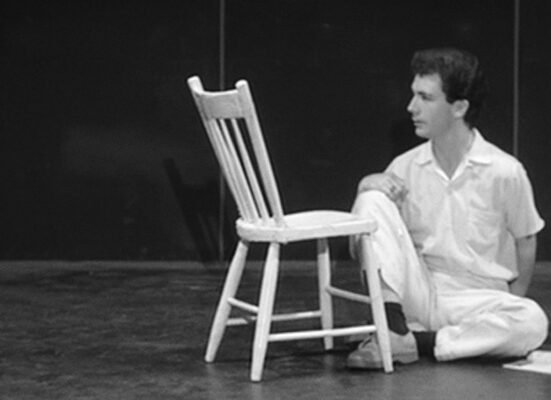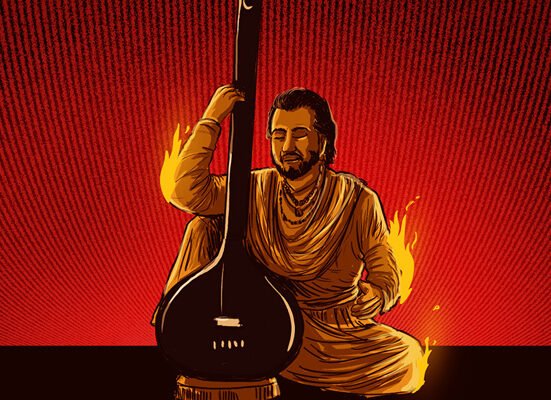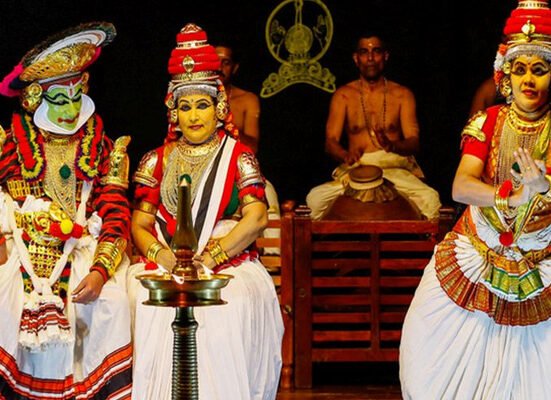Kuchipudi, which is one of the eight classical dances of India, traces its name and origins from ‘Kuchelapura’ or ‘Kuchipudi’, a small village in the Krishna district in Andhra Pradesh. Starting around 500 years ago, this dance-drama tradition was designed by a group of brahmin artists when the Vaishnavite religion had begun spreading in the region. These dance teachers would select and compose the dance-drama based on certain episodes from the ‘Bhagavatha’ and these were performed by artists who came to be known as ‘Kuchipudi Bhagavathalu’.
In India, the dance tradition is categorised into two; the first is the Devadasi dance tradition focused on prayers and belonging to the religious sphere and the second, is the dances that are performed outside the boundaries of the temple for the general public, which belong to the mundane variety. Kuchipudi is a dance tradition that began in order to keep the devotion of the people to dance and music alive. It is said that the people from the cities such as Amaravathi and Vijayawada were incredibly devoted to the culture of music and dance that was prevalent in this region and this is visibly reflected in the Kuchipudi dance style.
In 1502 A.D, the Brahmin Bhagavathalu group promoting Kuchipudi was formed and these groups only consisted of male performers. Even female roles were performed by well-trained men and these performances were considered to be special offerings to the designated deities. It is to be noted that even though women were not allowed into these groups, the ‘Nattuva Mela’, was the dance repertoire in Kuchipudi which was solely performed by women artists. The Nattuva Mela is a solo dance performed by women and this style of dance may consist of items which portray both Sringara bhava and Bhakti bhava.
An interesting anecdote that is attached to these Kuchipudi Bhagavathalu artists says that once when they were invited to perform before the Vijayanagara king, Veera Narasimha Reddy, they composed a dance-drama that exposed the misdeeds of one of his vassals and this act of theirs not only helped the king to become aware of the wrongdoings prevalent in his kingdom but also brought about fame to the Kuchipudi Bhagavathalu artists.
When the power of the Vijayanagara kingdom gradually began to wane, the proponents of the Kuchipudi dance tradition started seeking patronage from the Nayak kings of Thanjavur in erstwhile Tamil Nadu. They were provided with the necessary lands and grants for living by Achuta Nayaka and eventually, the place of their residence came to be called ‘Achutapuram’ and today, it is famously known as ‘Melattur’.
While speaking about the history and origins of the Kuchipudi dance tradition, it is essential to remember Theertha Narayana Yathi and his disciple, Siddhendra Yogi for their remarkable contributions to designing and developing this dance style. Theertha Narayana Yathi was a composer of Carnatic music and a sanyasi of the Advaita Vedanta and he is renowned for his composition in Sanskrit, titled ‘Krishna Leela Tarangini’, which deals with the life of Lord Krishna, beginning from his childhood till his marriage to Rukmini.
Siddhendra Yogi’s journey in life from a seemingly useless youth called Siddappa, who was scorned by the villagers, to that of a determined man who started studying the ‘shastras’ and who eventually composed the dance-dramas seen in Kuchipudi today, is a noteworthy achievement. He was a disciple of Theertha Narayani Yathi and following his guru’s footsteps, he wrote the play, ‘Bhama Kalapam’, which can be considered his magnum opus. This play is a beautiful mixture of dance, music and rhythmic patterns.
Siddhendra Yogi lived as an ascetic and he specifically taught the role of Satyabhama to the others while insisting on the fact that this character must be played by the artists at least once in their lifetime. It is said that initially, he faced hardships in finding the appropriate performers for this play and finally, he was able to find a group of young Brahmin boys who hailed from a village called ‘Kuchelapuram’. It is from this village that Kuchipudi derives its name and while searching for the etymological origins of the name of the village, it is believed that it is deduced from the Sanskrit name ‘Kusilavapuram’, meaning “the village of actors.”
‘Golla kalapam’ by Bhagavata Ramayya, ‘Prahlada Charitam’ by Tirumala Narayancharyalu and ‘Usha Parinaya’ by Chidambara kavi are well-known dance-dramas in the Kuchipudi dance tradition. In ‘Bhama Kalapam’, the artists present the role of Satyabhama using various facets of the ‘Ashta-nayaki’ tradition such as the ‘swadheena patika’ (who treats her lover with familiarity and shows a hint of pride in it) or the ‘vipralamba nayaki’ (one who feels deceived and dejected by her lover).
Some defining dance styles within the Kuchipudi dance tradition which give it a unique touch include, the ‘Vinayakatala Nritya’, the ‘Simhanandana tala Nritya’ and the popular ‘pot dance’ in which the dancer keeps a pot filled with water on their head and dances while balancing their feet on a brass plate. This particular dance has immense spiritual meaning and the technique through which the dancer skilfully balances themselves without spilling a single drop of water or losing grip on the brass plate makes the Kuchipudi dance style truly remarkable.
Over the years, Kuchipudi dance has evolved and today, the dancers who have gained a certain level of mastery over it are adding elements of their own and presenting it in new ways. The dramatic element in Kuchipudi dance is a salient feature of this dance form and especially, the ‘vachika abhinaya’ or vocal rendering by the dancers, sets it apart from other dance styles. The accompanying artists on the ‘mridanga’ and ‘tala’ provide the ‘sruti’ and sing the story, making the performance one which is not only visually appealing but also pleasing to listen to. The ‘aharya’ or costumes and make-up of the performers are subtle and not over-the-top. Characters who are central to the story are given make-up that is distinct from the rest and the same applies to female characters as well. Female characters wear ornaments such as ‘rakudi’, ‘kasina sara’ and ‘chandra vanki’ and long braided hair adorned with flowers and jewellery.
Following the paradigms listed by Bharata Muni in the ‘Natyashastra’, several Kuchipudi artists follow various roles. The ones who practise the dance and music are called ‘chatras’ and the Bhagavathalu artists are further divided into three categories: the first is the characters who present the dance-dramas and aim to entertain the people in a simplistic manner; the second is the ‘Pagativeshalu’ who travel across various regions and enact dance-dramas that have a humorous or political flavour to it; the third one is the ‘Natyacharyas’ or the gurus who are respected for their knowledge of the dance form and are involved in teaching it to the others.
It is interesting to note that Andhra Pradesh boasts of yet another beautiful dance form known as the ‘Vilasini Natyam’, which was performed by the Telugu Devadasis and this dance repertoire is known for its three distinct styles; the temple tradition (aalaya sampradaya), court tradition (kutcheri aata) and theatrical presentation (aata bhagavatham). According to Swapnasundari, a renowned Kuchipudi dancer and exponent of Vilasini Natyam, even though both these dance forms originate from the same region, they are visibly distinct as “Vilasini Natyam consists of over 100 nritta units (basic ‘adavus’ and their permutations and combinations) in the Northern and coastal school alone. Another 35 to 40 nritta units are of the Southern school.” These ‘adavus’ are not found in the old sampradayam of Kuchipudi and the approach and methodology of ‘abhinaya’ in Vilasini Natyam also differ from what is currently followed in Kuchipudi. Another feature that differentiates the two from each other is the fact that Kuchipudi is a dance form that belongs to the ‘purusha sampradayam’ while Vilasini Natyam quintessentially belongs to the ‘stree sampradayam’. Today, this dance style is slowly declining and few dancers are putting their heart and soul into keeping it alive and having it retain its rightful place among the traditional dance forms.







Leave feedback about this